Fusion power has been a dream for mankind for decades now, but despite attracting perhaps more time, money, and attention than any other technological goal, the dream of fusion power has remained largely that; a dream. The history of fusion power is littered with shattered dreams and false starts, but it looks like, for the first time, there are some promising signs and significant milestones being achieved in fusion power.
Venture capitalists of all stripes have continued to pour money into fusion power, and there are certainly some interesting commercial milestones being achieved, but the most promising work right now might be that coming from Germany. Related: Political Climate Shifting Against The Oil And Gas Industry
The problem with fusion power has always been that in order to get the approach to work, superheated gases with a temperature of roughly 100 million degrees Celsius have to be harnessed to generate the needed atomic behavior. At that heat, electrons are ripped away from atoms which leaves a plasma “slurry” of electrons and ions. This also makes the ions travel fast enough to overcome their mutual repulsion and fuse resulting in fusion power. But gas heated to this level – several times the heat of the sun – is also impossible to contain in a normal vessel made of any matter known to man. Instead, the only way to hold these gases is in a magnetic cage. Related: Energy Storage Could Become The Hottest Market In Energy
That’s where Tokamaks come in. These devices are the current standard in fusion research. Tokamaks are essentially coiled magnetic cages designed to contain the plasma gas used in fusion power. Tokamaks have been the focus of research in fusion power for decades now culminating in the massive international effort to build the world’s biggest tokamak. The project, called ITER, is based in France and will cost more than $15 billion to build. ITER is supposed to represent the next real steps towards a commercially viable fusion reactor. But the project faces a major problem because it is a tokamak design. Tokamaks use internal coils that can only control the plamsa in short bursts, which actually ends up using more energy than is generated. Structurally, the tokamaks are an aesthetically appealing design, but it is unclear if the torus shape they are based can lead to the breakthroughs needed to make fusion a viable source of energy. Related: Canada’s Oil Sector Cautiously Optimistic About Late 2016 Recovery
The alternative is a much uglier device called a called a stellarator. Stellarators look like something out of a junkyard, but they avoid the design problems that plague tokamaks. Instead, of using internal magnetic coils as tokamaks do to create the magnetic cage, stellarators rely on external coils. The design of both tokamaks and stellarators is incredibly complex of course, but in theory, tokamaks are more efficient, which is why they have become the standard. However, Stellarators have the potential to avoid a series of potential design issues if they can be produced with the needed quality and precision.
The Germans have spent the last couple of decades working on the world’s largest stellarator. After more than 1 million construction hours and a billion dollars, the huge machine is finally complete. The 52 foot diameter stellarator called the W7-X required very precise construction and tolerances on parts, but the machine now appears ready to go after more than a year of tests. Very few stellarators have ever been built, and the German model is the first real opportunity to test the design on a large scale. If initial tests prove successful, the Germans could upend the field of nuclear fusion and pave the way for the start of a demonstration commercial fusion plant sometime in the next decade. The device is scheduled to begin full testing later this month, once it has received all necessary regulatory approval.
By Michael McDonald of Oilprice.com
More Top Reads From Oilprice.com:
- Only 1 Percent Of Bakken Shale Is Profitable At These Prices
- Oil Markets Shrug Off Supply Disruptions In Libya And Brazil
- Is Iran Opening A “Secret Passage” To Asia For Russian Crude?



















We should also remember that airplanes don't fly by flapping their wings. All efforts to fly by that means led to failure. These extraordinary efforts to make mini-suns here on planet earth will similarly lead to failure. We need a different approach. A misplaced mimicry of nature can lead down the wrong road.
We already have a perfectly good nuclear fusion reactor. And every morning, without fail, it rises in the East.